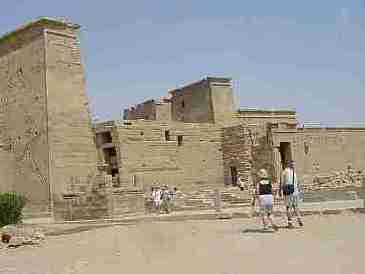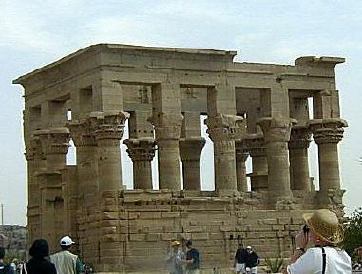Philae, one of three small islands at the south end of the First Cataract of the Nile, had long been sacred to the goddess Isis but the first construction on it dates only from the reign of Taharqa (690-664 BCE-25th Dynasty). (Remember his column near the present-day entrance to Karnak?) The Isis temple we visit today initially was built even later, by Ptolemy II Philadelphus (285-246 BCE) and his successor, Ptolemy III Euergetes (246-221 BCE). The Ptolemies, the last of whom was Cleopatra VII, ruled following the division of Alexander the Great's empire. Thus, the Ptolemies were Greeks, not Egyptians. We have come a long way in time, about 1000 years, since Ramesses II and Abu Simbel. Philae is really, really young! Simply to think such a thing is to be impressed by the antiquity and constancy of artistic expression of this civilization.
But the placement of "Philae" is a whole lot younger than the difference between its original construction and that of Abu Simbel. Because "Philae," like Abu Simbel, has been moved; it is now on an close-by island called Agilkia, which is high enough to escape the constant flood of Lake Nasser. A visitor today doesn't know the difference. But, then, a visitor today is unlikely to be a devotee of Isis who thinks the original real estate is sacred.
The first pylon of the Isis Temple (show above) has a number of interesting features. Take, for instance, the figure of a Ptolemaic pharoah (Ptolemy XI Neos Dionysos) putting down his enemies or prisoners on the left pylon. Just like Ramesses -- but 1000 years later. Plus ça change, plus c'est la même chose.
Let's now take a closer look at the right side of the pylon.
 | Here we see Horus between two images of his mother, Isis, and another figure of Isis is visible within the doorway. The myth that details the way Isis collected the parts of her husband Osiris after he had been dismembered by his evil brother, Seth, reassembled them for him to live sufficiently long to impregnate her -- Horus was the result -- was powerful for century upon century of Egyptian history. It continued to be powerful into the Roman Empire and was a vibrant rival of Christianity in that new religion's first centuries. The Temple of Isis at Philae functioned until the time of the Emperor Justinian I (527-565 CE) when it was converted into a church. |
 The Roman influence is evident in this view of the two pylons of the temple with the "passage of Tiberius" visible just over the head of the tourists in the foreground. |  More Roman evidence: This freestanding pavillion is attributed to the Emperor Trajan. Other parts of the temple complex are assigned to Hadrian. |